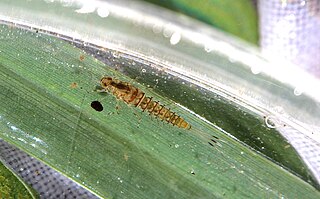William Elford Leach was an English zoologist and marine biologist.
The Battle of the Baetis River was fought between an army of the Roman Republic and a rebel army at the Baetis river in Spain. The battle took place in 80 BC at the start of the Sertorian War. The Romans were led by Lucius Fufidius, while the rebels were led by the Roman rebel Quintus Sertorius. The rebel army was victorious, gaining Sertorius control over Hispania Ulterior.
The Sertorian War was a civil war fought from 80 to 72 BC between a faction of Roman rebels (Sertorians) and the government in Rome (Sullans). The war was fought on the Iberian Peninsula and was one of the Roman civil wars of the first century BC. The Sertorians, a coalition of Celts, Aquitanians, Iberians and Roman and Italic rebels, fought against the representatives of the regime established by Sulla. The war takes its name from Quintus Sertorius, the leader of the opposition. It was notable for Sertorius' successful use of guerrilla warfare. After many years of battles and ambushes, Sertorius eventually lost control over his coalition, while the Roman Senate continued to finance efforts to subdue him. The war ended after Sertorius was assassinated by Marcus Perperna, who was then promptly defeated by Pompey.

Baetidae is a family of mayflies with about 1000 described species in 110 genera distributed worldwide. These are among the smallest of mayflies, adults rarely exceeding 10 mm in length excluding the two long slender tails and sometimes much smaller, and members of the family are often referred to as small mayflies or small minnow mayflies. Most species have long oval forewings with very few cross veins but the hindwings are usually very small or even absent. The males often have very large eyes, shaped like turrets above the head.

Lestes is a genus of damselfly in the family Lestidae. The family hold their wings at about 45 degrees to the body when resting. This distinguishes them from most other species of damselflies which hold the wings along, and parallel to, the body when at rest.

Baetis is a genus of mayflies of the family Baetidae, known as the blue-winged olive to anglers. There are at least 150 described species in Baetis. They are distributed worldwide, with the most variety in North America and northern Europe.
Diphetor is a genus of mayflies in the family Baetidae,
In the 10th edition of Systema Naturae, Carl Linnaeus classified the arthropods, including insects, arachnids and crustaceans, among his class "Insecta". Insects with net-veined wings were brought together under the name Neuroptera.

Baetis intercalaris is a species of small minnow mayfly in the family Baetidae. It is found in the south half of Canada and the continental United States.

Baetis tricaudatus is a species of small minnow mayfly in the family Baetidae. It is found in Central America and North America. In North America its range includes all of Canada, all of Mexico, and the continental United States.
Baetis alius is a species of small minnow mayfly in the family Baetidae. It is found in the northwestern United States.

Baetis sahoensis is a species of mayflies in the genus Baetis. It lives exclusively in Japan, with reported sightings near the cities of Osaka and Sapporo.
Baetis bicaudatus is a species of small minnow mayfly in the family Baetidae. It is found in southwestern, northern Canada, the western United States, and Alaska.

Baetis flavistriga is a species of small minnow mayfly in the family Baetidae. It is found in Central America and North America. In North America its range includes all of Canada, all of Mexico, and the continental United States.
Baetis notos is a species of small minnow mayfly in the family Baetidae. It is found in Central America and North America. In North America its range includes southern Mexico, the southern, and northwestern United States.
Baetis brunneicolor is a species of small minnow mayfly in the family Baetidae. It is found in all of Canada, the northern, and southeastern United States.

Baetis pluto is a species of small minnow mayfly in the family Baetidae. It is found in North America.
The Battle of Lauron was fought in 76 BC by a rebel force under the command of the renegade Roman general Quintus Sertorius and an army of Roman Republic under the command of the Roman general Gnaeus Pompeius Magnus. The battle was part of the Sertorian War and ended in victory for Sertorius and his rebels. The battle was recorded in detail by Frontinus in his Stratagems and by Plutarch in his Lives of Sertorius and Pompey.








